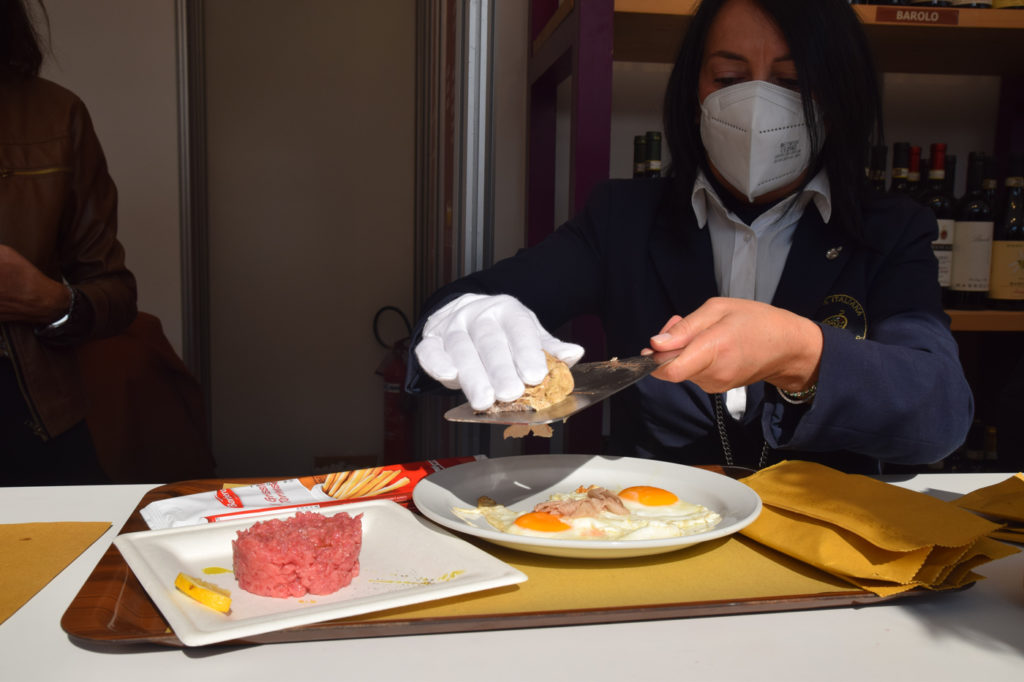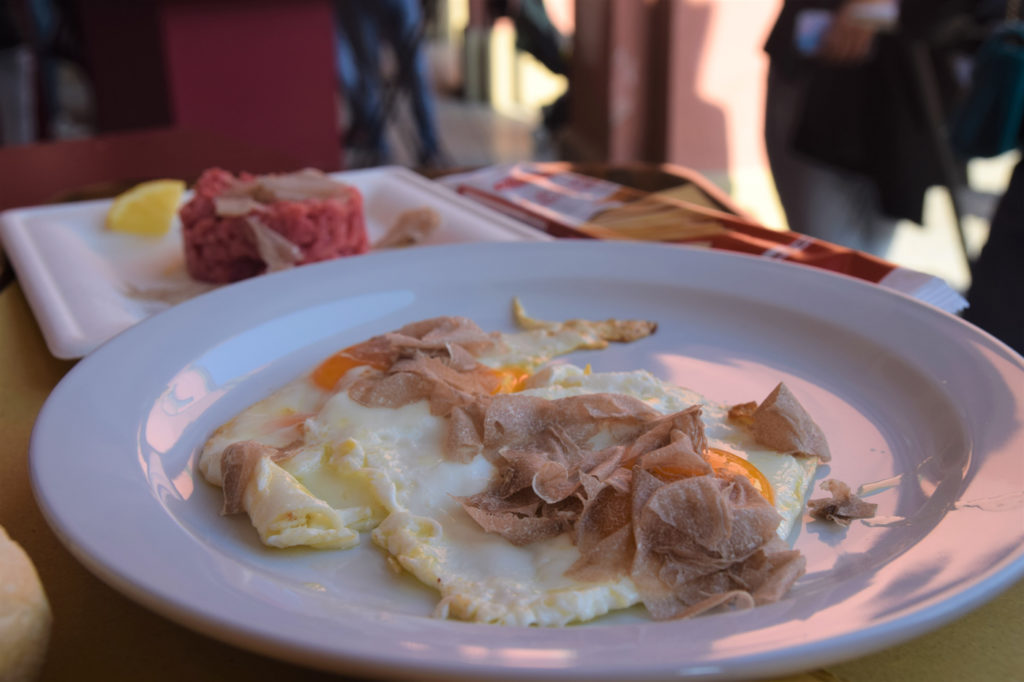Truffles in Turmoil
White truffles are becoming even more of a rarity as global warming damages their habitat.
Editor’s Note: this story was originally published in The Industry Issue of Life & Thyme Post, our exclusive newspaper for Life & Thyme members. Subscribe today.
As fall brings damp mists and dropping temperatures to the northwestern Italian region of Piedmont, white truffle hunters set out with their dogs into the woods around the city of Alba. Hidden beneath the wet earth are knobbly beige tubers that are among the most prized ingredients in the gastronomic world, priced on par with saffron and caviar. However, although they can already fetch thousands of U.S. dollars per kilo, white truffles may soon sell for far more as climate change threatens the delicate environmental conditions in which the fungus thrives.
In October and November each year, the city of Alba, located just south of Turin, gives itself over to truffles. Walking around the center, a sudden whiff of a pungent garlicky scent signals a street-side stall selling black and white truffles among other local products like porcini mushrooms, salami and Castelmagno cheese. Restaurants in the city and nearby vicinity advertise truffle-themed menus and are packed with diners at lunch and dinner hoping to try the delicacy. At Locanda del Pilone, a Michelin-starred restaurant just outside Alba that fills its menu with the tuber each fall, preparations are beginning in the kitchen for Sunday lunch. Chef Federico Gallo serves up dishes like fried eggs, fondue, and egg pasta with butter topped with truffle shavings (the addition of truffle to a dish normally adds around $40 to $50). These dishes are ideal because the fattiness of the eggs and butter amplifies the earthy flavors of the truffle, the heat wafts its scent up to the nose.
The largest event of the season is the International Alba White Truffle Fair, which takes over a couple of squares in the town center. It began as a small local festival and is now a prestigious event in its 91st year. Hunters and vendors display their truffles on blue-checked cloth like gems in a jewelers’ window—only after the products have been inspected and valued by a panel of expert sensory analysis judges. These judges scrutinize the products for imperfections, check for freshness, and ensure there is not an excess of soil adding to their weight. Renowned chefs put on cooking shows, wine tastings demonstrate how to pair the tuber with the potent local wines like Barolo and Barbaresco, and visitors can partake in a sensory analysis course to become more acquainted with the varying truffle aromas.
Alba is synonymous with white truffle because the dense forests in the surrounding Langhe, Monferrato and Roero areas create prime conditions for the fungus to grow. This tuber magnatum pico develops underground in symbiosis with trees such as oak, elm and birch. By October, truffles are usually ready to harvest. Truffle hunters, many now elderly men whose families have been in the trade for generations, train specialist dogs to sniff out the tuber’s potent scent, even when buried a meter underground. It is a moment of insuppressible excitement when the canine hunter identifies the odor and begins to dig furiously, revealing the misshapen surface of a pale golden lump.



However, the precious white truffle is, along with many products in the world like coffee and chocolate, at existential risk from climate change. In order for truffles to be of good quality and ready to harvest in the fall, the weather throughout the year is critical. Beginning in winter, snow is fundamental for ensuring water penetrates deep into the soil. Then, to stimulate growth, there must be adequate rainfall in the summer months to create the correct soil humidity (which varies slightly depending on the local tree variety).
Now, rising temperatures and reduced rainfall are jeopardizing the truffle’s growth. Low rainfall also lowers the quality of the truffle, which tends to become dried out. According to local hunters, truffle production has been slowing over the last 40 to 50 years. Bruno, an 81-year-old trifolao (truffle hunter in local dialect), says in the ‘70s and ‘80s he was bringing armfuls of the fungus to sell at the fair—sometimes four kilos a week. Now, he’s lucky to find 200 grams.
Those in the business give the lion’s share of the blame to the hotter and drier summers that are reducing the soil’s humidity. Five of Europe’s hottest summers of the last 500 years occurred in the last 15 years (Sicily broke the record temperature for Europe this summer hitting 119.84 degrees Fahrenheit). In 2017, truffle prices skyrocketed due to scarcity after a dry summer. In 2019, there was a particularly warm October which delayed hunting season to November. This year, the outlook is just as worrying.
In a bar in a nearby village, a group of elderly men discusses when to start hunting. It’s October 16, and so far, very little of the tuber has been found. Guido, whose bad knees will prevent him hunting this year, gives a dire warning. “I’m worried this year, prices will be sky-high,” he says. “There are fewer and fewer truffles each year.” He also advises caution when ordering extra truffle shavings on a dish in a restaurant. “One thin slice can set you back €20 [$23], and if you don’t tell them to stop grating, they won’t,” he says with a sly smile.
At the fair, the prices speak for themselves. In good years, truffles go for around $2,000 to $4,000 per kilo. This year, the average is around $5,000 per kilo, creeping up to $7,000 for good specimens—bigger tends to be better, but a rounded form, scent and freshness are also important factors. It is an indication that this year, conditions were distinctly unfavorable.

Sebastiano Tona delivers truffles around the world with his company Sebastiano Tartufi. He explains that this summer, the region suffered an agonizing 83 days without rain, meaning truffles are now struggling to grow. Torrential rain and flooding were also precarious as they washed away the top layers of soil. Global warming and climatic change mean the situation this year will likely be the trend from now on, and Tona says bluntly, “In 20 years, there will be no more truffles.”
The organizers of the International Alba White Truffle Fair, which runs until December 5 this year, consider the issue so critical that they have made climate change the central theme of this edition. “Truffle is a natural product and its presence and quantity depend solely on natural elements,” says Director Stefano Mosca.
He describes the emphasis on the environment and sustainability this year as a way to “confront the next decades.” Not only does the fair adhere to European sustainability standards, it is also holding a series of talks where leading figures in a wide variety of sectors from fashion to finance discuss concrete actions they have undertaken to combat climate change. “This is the beginning of a cycle which will happen every year, and which will place the fair in the contemporary, global situation,” Mosca says. “Today, we can no longer pretend that our planet isn’t changing.”
With the truffle supply dwindling, the fair also wants to encourage landowners and hunters to protect and care for the natural environment—woods are also being cleared to make space for lucrative hazelnut farms (the Ferrero company, which makes hazelnut-based confectionary, has its headquarters in Alba). While truffles grow spontaneously and cannot currently be cultivated, some human intervention can stimulate growth. It is important to clear dead branches and rotten wood in the forests, for example. The National Center for Truffle Studies, which is based in Alba, also wants to encourage locals to plant trees that will promote the tuber’s growth.
Years like this are problematic for the hospitality industry. White truffle is sought after by epicureans around the world. For local restaurants like Locanda del Pilone and eateries across the globe, it is vital to source enough of the fungus each season and, as the prices at the fair show, it’s an expensive business (the tuber isn’t dubbed “white gold” for nothing). While regional restaurants will pay prices like those at the fair, if truffles are transported to the United States, for example, the price can be almost 10 times more. As truffle vendor Tona explains, this is because the fungus is extremely perishable, meaning he often has only 24 hours to deliver it across the Atlantic.
Truffles are also not the only prized Italian products to become victims of the warming planet. A risk analysis of climate change in Italy, undertaken in 2020 by the Euro-Mediterranean Center on Climate Change, warned of the harm that could befall olive trees in the coming years. Southern regions like Calabria and Sicily will experience a reduction in rainfall, increased desertification, and rising temperatures. Summer droughts have already been so disastrous for olive trees that some farmers on the island of Sicily have swapped olive oil production for growing avocados, which fare better in the increasing temperatures.
The diminishing supply of truffles and many other prized ingredients will be an expensive blow to the restaurant industry. But more importantly, they are also a warning of the damage being caused to the wellbeing of our planet and its natural ecosystems. As Mosca says, white truffles should be seen as an “indicator of the state of nature and its changes.”






Our comments section is for members only.
Join today to gain exclusive access.